A Tale of Two Languages: How the Persian language seeped into Bengali
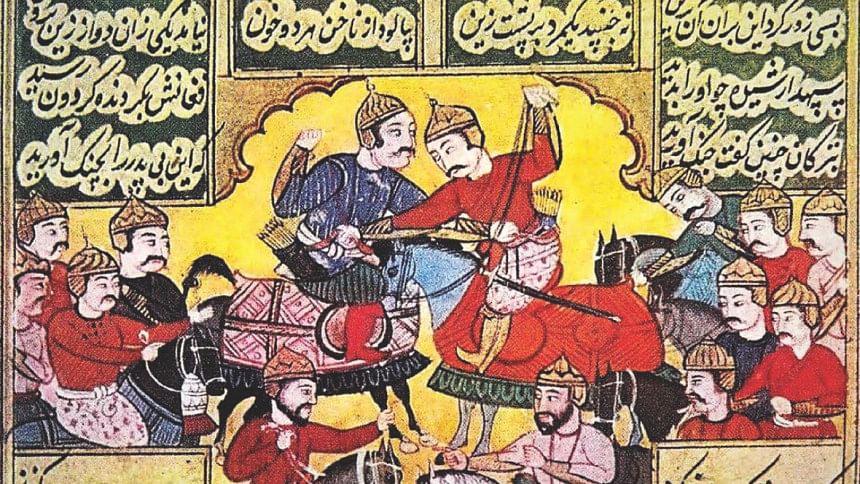
Think of some of the words we use most often in our daily lives in Bengali. The word for 'pen'—kolom; the word for 'sky'—asmaan; 'river'—doria; 'land'—jomeen. Think of the standardised farewell greeting of Khoda Hafez even among some non-Muslims in social situations, and the knowledge of most Muslim Bengalis of the Arabic script, even if they do not understand the language. Derived from Persian and Arabic origins, these words, expressions, and practices, among countless others, have become so deeply ingrained in Bengali that we seldom spare thought to their foreign lineage. But a glimpse into the history of these linguistic concoctions reveals just how porous and pulsating language can be, and how rich Bengali as become over the centuries as a result of travelling cultures.
As Suniti Kumar Chatterjee explains in The Origin and Development of the Bengali Language(1926), Bengali predates the age of the province of Bengal in pre-partition India, originally a part of the Eastern Indo-Iranian or Aryan branch of the Indo-European languages. Having previously settled in Eastern Iran, Aryan speakers supposedly came to India around 1500 BC, when the first Vedic hymns are said to have been produced. Among the oldest references to Bengali include the ancient Brahmi script found in Ashokan rock edicts, the Bengali commercial and industrial works from the Kusana period mentioned in the Greek Periplus of the Erythraean Sea (1st century AD), Bengali place names found in inscriptions of old books from the first half of the 5th century AD, and a glossary of 300 words in a 'scattered' Sanskrit commentary on the Amara-kosa by Bengali Pandit Vandhya Ghatiya Sarvananda from around 1159 AD.
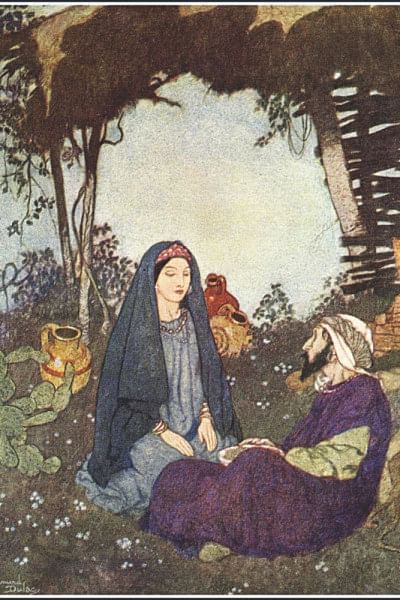
The Persian influence on Bengali dates back to the 13th century Turkish invasion of India. The year 1206 saw the migration of many Persian and Central Asian poets to India, resulting in the assimilation of Persian literary trends into the Indian cultural landscape. While the influence on the Delhi headquarters was particularly evident from the development of Urdu—a mixture of Hindi and Persian languages—its impact on Bengal stemmed from a number of sources over several centuries.
Firstly, the Muslim kings of the 15th and 16th centuries are said to have been "active patrons of Bengali literature", according to Chatterjee, while the practices of the Sultan's court are also said to have pushed Bengali chiefs into mastering Persian as part of their job. Secondly, the Iranians flocking into India, many of them Shia Muslims, settled in the (present-day Bangladeshi) cities of Murshidabad, Dhaka, and Hugli among others, and took up positions as Ulamas, teachers, and poets in Bengal, much like the Arab sea-traders who had entered through the ports of Chittagong earlier in the 8th century. The result was a growing popularity and eventual mythologisation of Persian tales among Bengali people—such as that of Laili and Majnu, Yusuf and Julekha, or the works of Ferdousi, Jami, and Nizami—and an absorption of Persian words into the Bengali language. Some 10,000 Bengali words came to be influenced by Persian, and around 5,000 were borrowed directly from Arabic, Persian, and Turkish. Persian remained the official state language of Bengal for 600 years, until the British changed it to English around 1836.
This entry and eviction of Persian has been flagged for decades as milestone events in the development of the Bengali language. But it is the nature of the Persian impact, and not the fact of the impact itself, that contains a more intriguing message—a reminder of how language, human thought, and history operate. Afia Dil, in her article "Impact of Arabic Language on Bengali Language and Culture" (2012), singles out the Manasavijaya written by the poet Biprardas Piplai as "evidence of the influence of the language of the Muslim rulers" on Bengali. Using Qazi Abdul Mannan's analysis of the poem, Dil first highlights a stanza which translates to: "The Qazi declares the court open, Taking up the Qu'ran the sacred book…". It offers a glimpse into how Muslim courtly and religious practices appeared in the work of a Hindu poet at the end of the 15th century. Assuming the accuracy of the translation and focusing only on these lines at our disposal, we also notice how the present tense and clear focalisation of the language situate the reader within the scene of the Qu'ran being opened.
The absence of a past tense in the narration, the accurate spelling of the Qu'ran, and the reference to it not as the book of another religion but simply as "the sacred book" wipe out the lines separating Muslim beliefs, the Hindu narrator, and the reader, whatever his/her background. It points towards coexistence, instead of mere familiarity, among the Hindus and Muslims during the time of this poem.
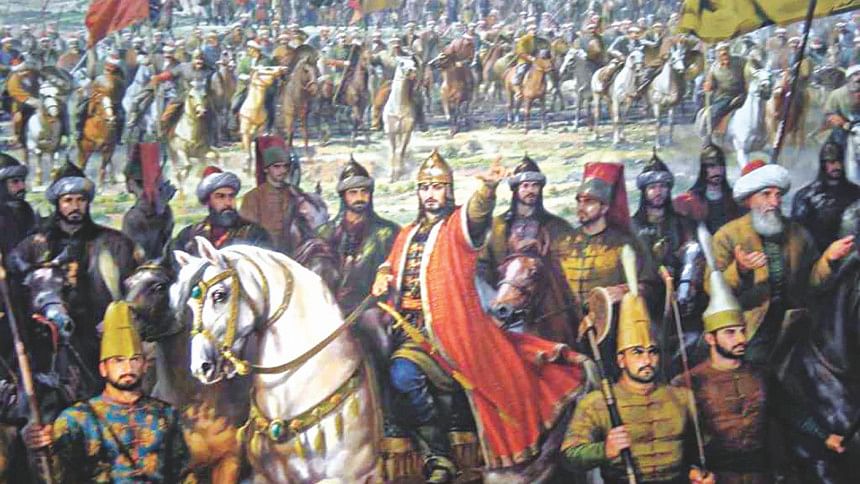
Dilalso mentions how 20 nouns out of the 40 words selected from this poem have Perso-Arabic origins, as well as other instances of 'Dobhasi' (duo-lingual) literature, including a Brahman poet's work Chandimangalin 1589 (20 out 68 words Perso-Arabic), and Hindu poet DvijaGiridhar's Satyapirerpachali from the 17th century (24 out of 39 selected words Perso-Arabic), among others. While the earlier example of Manasavijaya reflected the socio-cultural coexistence of Muslim practices among Bengali Hindus, these other duo-lingual works highlight how this coexistence trickled into the Bengali language, tying up Persian and Arabic words into the very fabric of Bengali, colouring its expressions, its phrases and sections of words in a gradual yet intricate pattern. When the British and Hindus sought to replace it with English 600 years later, the publication of the 'Musulmani' books proved just how deeply Persian and Arabic had infiltrated the Bengali language.
The books, published from the 18th century onwards, contained poetry, history, religious stories and tracts, and instructions for daily life read by ordinary Bengalis like shopkeepers, boatsmen, servants, etc.
In his Introduction to The Origin and Development of the Bengali Language, Chatterjee recalls how, "A young generation of Musalman poets and prosateurs [were] [...] transforming the stilted literary Bengali into a natural language [...] and keeping true to its native spirit as a Sanskritic language". Meanwhile, he adds, some Urdu-speaking Maulavis were also establishing a form of "Musalmani Bengali" that used Persianised language and retained the Bengali metre to tell adapted versions of Persian romances and other Muslim stories. The publications, of which 24,600 copies were printed for sale, included stories about the Prophet Muhammad's life and family, biographies of other historical religious figures like Moses and Kaliph Omar, famous love stories, and other Islamic tracts and teachings, according to Abhijeet Ray in James Long'er Bangla Boier Shaatti Catalogue. A typical 'Musalmani' Bengali book (a five-page folio) was likely to have 31.74 percent of the words from Perso-Arabic descent, compared to 40 percent Persian words in an Urdu ghazal, according to Chatterjee. Most interestingly, unlike the regular Bengali books that open from right to left, many of these 'Musulmani' books still had a cover opening from right to left, but the text inside ran from the back page onwards. The pages, therefore, were numbered accordingly, meant to be turned from left to right the way the Qu'ranis read.
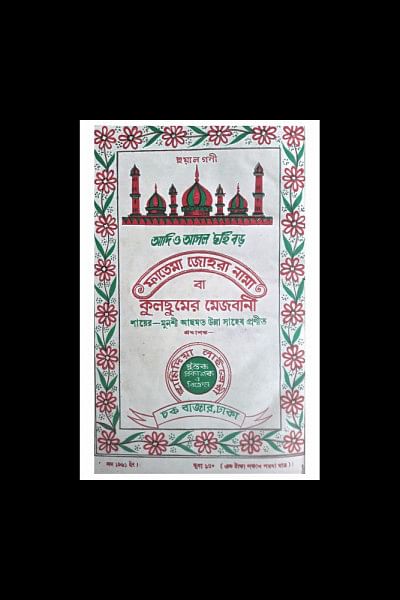
These stubborn remnants of Persian influence in the face of the British decree highlight the independent working mechanism of languages, which in turn influences the content of books published in a space. Regardless of the official ban on Persian as a state language, its influence on Bengali seems to have exerted much stronger control in the 18th-19th centuries, evolving from the periodic appearance of Muslim practices in Bengali works in the 15th century, to entire publications devoted to Muslim stories and teachings printed in the 19th century; from Muslim words and expressions nestled amidst Bengali vocabulary earlier, to an entire directional shift in the Bengali script later.
It pushes one to appreciate the dual dimensions of a book, particularly the 'Musalmani' books. On the one hand, these publications were a product, i.e. a direct result of the enduring influence of the Persian language on Bengali. They serve, therefore, as relics from which we can gather clues about the sociolinguistic forces that caused them. At the same time, they were tools through which Bengali Muslims under the British rule maintained a distinct identity through their published literature. Given that published books point towards a demand, a market for that literature, the popularity of these 'Musulmani' books in the 18th-19th centuries reveals how both writers and readers maintained a distinct Bengali Muslim identity during this time. Considered collectively, these messages contained in the Bengali 'Musulmani' books push us to think more critically about the books found from a certain space. We are reminded that nuances exist even within a single language, and that they contain a multiplicity of histories even within individual words and phrases.
While these influences were originally taking effect, however, scholars of the 18th-20th centuries were debating whether it ought to be seen as a corruption of or an improvement to the Bengali language. It's a question pertinent to the study of any language, even today: as languages travel and spill into ever-expanding territories, do we resist the changes they bring to our speech in the spirit of preservation, or do we embrace the shifts as they come?
Sarah Anjum Bari can be reached at [email protected]




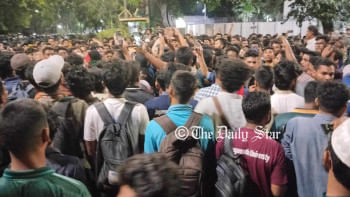
Comments